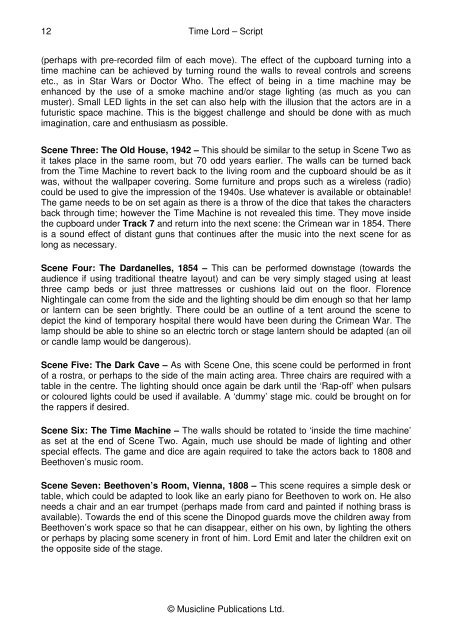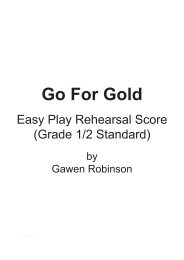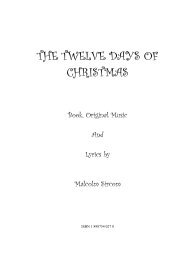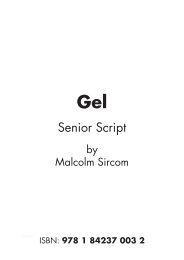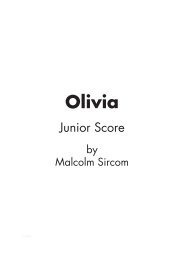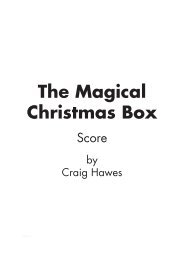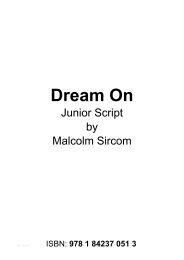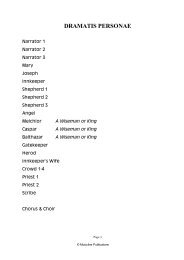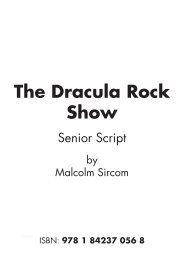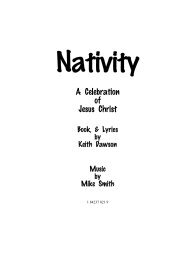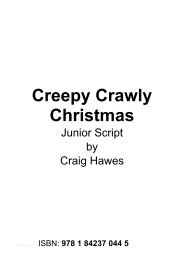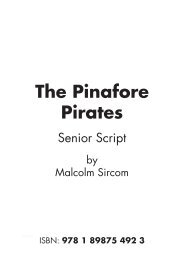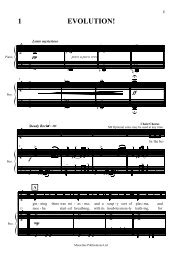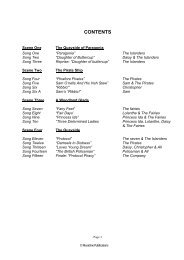Script Sample - Musicline
Script Sample - Musicline
Script Sample - Musicline
You also want an ePaper? Increase the reach of your titles
YUMPU automatically turns print PDFs into web optimized ePapers that Google loves.
12 Time Lord – <strong>Script</strong><br />
(perhaps with pre-recorded film of each move). The effect of the cupboard turning into a<br />
time machine can be achieved by turning round the walls to reveal controls and screens<br />
etc., as in Star Wars or Doctor Who. The effect of being in a time machine may be<br />
enhanced by the use of a smoke machine and/or stage lighting (as much as you can<br />
muster). Small LED lights in the set can also help with the illusion that the actors are in a<br />
futuristic space machine. This is the biggest challenge and should be done with as much<br />
imagination, care and enthusiasm as possible.<br />
Scene Three: The Old House, 1942 – This should be similar to the setup in Scene Two as<br />
it takes place in the same room, but 70 odd years earlier. The walls can be turned back<br />
from the Time Machine to revert back to the living room and the cupboard should be as it<br />
was, without the wallpaper covering. Some furniture and props such as a wireless (radio)<br />
could be used to give the impression of the 1940s. Use whatever is available or obtainable!<br />
The game needs to be on set again as there is a throw of the dice that takes the characters<br />
back through time; however the Time Machine is not revealed this time. They move inside<br />
the cupboard under Track 7 and return into the next scene: the Crimean war in 1854. There<br />
is a sound effect of distant guns that continues after the music into the next scene for as<br />
long as necessary.<br />
Scene Four: The Dardanelles, 1854 – This can be performed downstage (towards the<br />
audience if using traditional theatre layout) and can be very simply staged using at least<br />
three camp beds or just three mattresses or cushions laid out on the floor. Florence<br />
Nightingale can come from the side and the lighting should be dim enough so that her lamp<br />
or lantern can be seen brightly. There could be an outline of a tent around the scene to<br />
depict the kind of temporary hospital there would have been during the Crimean War. The<br />
lamp should be able to shine so an electric torch or stage lantern should be adapted (an oil<br />
or candle lamp would be dangerous).<br />
Scene Five: The Dark Cave – As with Scene One, this scene could be performed in front<br />
of a rostra, or perhaps to the side of the main acting area. Three chairs are required with a<br />
table in the centre. The lighting should once again be dark until the ‘Rap-off’ when pulsars<br />
or coloured lights could be used if available. A ‘dummy’ stage mic. could be brought on for<br />
the rappers if desired.<br />
Scene Six: The Time Machine – The walls should be rotated to ‘inside the time machine’<br />
as set at the end of Scene Two. Again, much use should be made of lighting and other<br />
special effects. The game and dice are again required to take the actors back to 1808 and<br />
Beethoven’s music room.<br />
Scene Seven: Beethoven’s Room, Vienna, 1808 – This scene requires a simple desk or<br />
table, which could be adapted to look like an early piano for Beethoven to work on. He also<br />
needs a chair and an ear trumpet (perhaps made from card and painted if nothing brass is<br />
available). Towards the end of this scene the Dinopod guards move the children away from<br />
Beethoven’s work space so that he can disappear, either on his own, by lighting the others<br />
or perhaps by placing some scenery in front of him. Lord Emit and later the children exit on<br />
the opposite side of the stage.<br />
© <strong>Musicline</strong> Publications Ltd.


